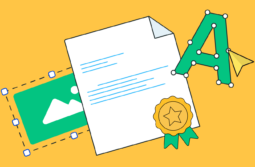The rapid development of eLearning helped unlock new opportunities both for students and teachers. Now there are plenty of ways to get any knowledge you need to be a highly qualified expert. You can also start your own eLearning business as a teacher if you have a fascinating hobby or valuable experience you want to share.
There are many online platforms that allow you to create lessons, enroll students, provide educational services, and sell online courses. For example, Thinkific, Teachable, and Kajabi are considered to be some of the most popular cloud-based online course platforms.
All you need to do is choose an online course platform that meets your needs. No technical skills are required — you can focus only on course development and marketing.
As the SendPulse Academy provides its free online courses, our SendPulse marketing team selected Thinkific as the most convenient to run them.
In 2022, our newly-launched online course builder became a part of the SendPulse ecosystem. This means that apart from creating courses, you also can:
- send email campaigns to communicate with students;
- launch chatbots to help out your support and sales teams;
- collect students’ data using the free CRM system;
- create a course registration landing page.
All these features are available within a single platform, so you don’t need to spend your time searching for other services to promote your course.
We moved the SendPulse Academy courses to our new course builder, a Thinkific alternative, to make the most out of SendPulse’s toolkit. In this post, we will talk about our experience of migrating from Thinkific and compare SendPulse’s online course builder and Thinkific.
Content:
Scope of the task and its stages
The SendPulse Academy offers free courses for digital marketing beginners and experts who want to learn more about the SendPulse tools, email marketing, chatbot development, landing pages, and online courses.
To start learning, users just need to register. Our students also receive certificates of completion, which motivates them to go through with their course.
Here is what we had to do:
- download all of our videos from Thinkific;
- create YouTube playlists for each course and upload our videos;
- create courses, lessons, and tests on our new platform;
- develop a certificate design;
- create a landing page for each course;
- download our student database from Thinkific;
- inform students that we are migrating from Thinkific and give them access to courses on our new platform.
Let’s take a closer look at each step.
Downloading 83 videos from Thinkific
Before starting to transfer content from Thinkific, we had to download all of our lessons and upload them to SendPulse.
With SendPulse, you can add videos to your lessons by uploading them to the file manager or adding a YouTube or Vimeo link.
For instance, if you have a lot of videos or your video is large, you can upload it on YouTube, just like we did, and then add a link to your lesson in the SendPulse drag-and-drop builder. Please note that students may share a link to your video.

If you want to protect your videos from unauthorized access, upload them directly to the file manager. SendPulse provides 1 GB of file storage space for free. With a paid plan, you can use from 15 GB to 400 GB of storage space.
Our Thinkific alternative also allows you to upload your files into different folders to be able to find them easily.

To add videos to lessons in Thinkific, upload them to the video library first and then select them from the drop-down list in the lesson builder.

Thinkific offers unlimited video hosting with any plan, and each video file cannot be larger than 2 GB. You can also add thumbnails and captions to your videos.

If you have a lot of videos, the Thinkific video library will look like a long list where you can search videos by name. If your video titles are similar, it may take some time to find the one you are looking for.
You can also edit, archive, download, or delete each video.

Since our courses are free, we decided to upload them to YouTube and add links to them in our new online course builder to transfer content from Thinkific.
When we downloaded all 83 videos from Thinkific, we ran into a problem — the name of each downloaded video was changed to a set of random characters. We had to rename each of them before uploading them on YouTube.
Afterward, we created new YouTube playlists and uploaded all videos, thumbnails, and captions there.

Moving from Thinkific to the SendPulse platform
Once we downloaded all videos, we started moving courses to our Thinkific alternative. Let’s talk about how we transferred our lessons and how the functionality of the two platforms differs.
Online course structure
Both platforms offer a handy drag-and-drop builder, so no technical skills are required to create an online course using these platforms.
With SendPulse’s online course builder, you can launch three courses for free. Our free plan allows you to invite one instructor, teach 200 students, and use 1 GB of file storage space.
To create a course with SendPulse, you need to register, go to the “EDU” section, click “Create course,” and select “New course.” Our ready-made course templates will be available soon.

Next, name your course and enter its URL. You can change these settings later and build your online course structure by uploading files and creating sections, lessons, and tests using our Thinkific alternative.

With Thinkific’s free plan, you can launch one course, create one community, add one administrator, teach an unlimited number of students, and make use of full video and content hosting.
With this platform, you can build your course from scratch or use ready-made course templates.

Name your course and enter its URL. You can change these settings later.
Lessons
SendPulse offers a visual builder where you can create sections and add lessons or tests to them. You can copy and edit your existing lessons or tests and move them from one section to another.
You can create full-fledged lessons and add videos, images, podcasts, infographics, tables, mind maps, summaries, and homework to each of them using our Thinkific alternative.

Click the three dots icon next to a lesson name to open its settings. Here, you can enable or disable access to your lesson or schedule content availability.
With a non-linear lesson flow, students will be able to view all lessons at once, and with a linear one, they will be able to view the next lesson only after completing the previous one. You can choose a lesson flow type in general course settings.

You can turn on the “On a date” toggle to choose when you want your lesson to become available. Alternatively, your lesson can run in a specified number of days after the previous lesson’s publication date.
You can also set an availability date for all lessons or tests in a section or an entire course. To do this, turn on the “Set the availability for” toggle and select an availability scenario.

In the Thinkific course builder, you can also create a new section and lesson or add or copy a lesson in an existing section. Also, you can move lessons from one section to another.

Thinkific offers ready-made lesson templates (Video, PDF, Text, Audio, Download, Presentation, and Multimedia). You can also run live lessons using Zoom or other services.

With Thinkific, you can’t mix multiple content types in one lesson. If your selected format is not suitable, you need to go back and create your lesson or test again.
Text or downloadable files can be added to some types of lessons as an option.

You can choose the following lesson settings:
- make it a free preview lesson and allow students to enroll for free and access all your preview lessons;
- make it a prerequisite lesson, meaning that students will be required to complete a prerequisite lesson accessing the next chapter(s);
- enable discussions for your lesson.
For some lesson types, you can make your multimedia files downloadable.

To schedule your lessons, go to the “Drip” tab and specify when your course content should be released. This option is available with paid plans.

Tests and tasks
With SendPulse, you can create tests and tasks directly in the course builder to assess your students’ knowledge. Enable multiple answers and add images, videos, or audio recordings to your questions. Our Thinkific alternative also enables you to duplicate or delete your questions and change their order.
Click on the three dots icon next to a test name to enable or disable students’ access to your tests, schedule test availability, assign points for correct answers and scores for passing the test, specify the number of attempts, and allow hints to be shown if a student chooses an incorrect answer.

Add tasks to your lessons and attach text, images, videos, audio recordings, or files to them. You can check students’ assignments yourself or use the “Auto-accept answers” option for easy tasks you don’t need to assess.
With the free plan, you can use the assignment features only for one course.

Thinkific offers you four types of assessment:
- Quiz. This assessment type allows you to add questions with multiple correct answers.
- Survey. This assessment type allows you to gather feedback from students.
- Assignment. This assessment type requires your students to submit a file to be reviewed by an instructor.
- Exam. This assessment type allows you to use advanced third-party platform features for student evaluation. Available with a paid plan.
Thinkific allows you to add images and videos to your questions. For the most part, we used quizzes as our main assessment type.

You can add a passing grade to your quiz if necessary. To schedule your quiz, go to the “Drip” tab.

Thinkific offers advanced quiz features, including randomizing your questions, adding files with explanations for students, and importing files to create quizzes and questions automatically.
General settings
SendPulse’s general course settings are gathered in one tab. Here you can upload your course preview that will be displayed in your students’ accounts and a hero image for your landing page. You can also set your course language and add descriptions.

You can choose the following course formats:
- Open-ended. This course format allows your students to take your course at any time.
- Specific dates. This course format allows your students to take your course only during the specified time period. They will not be able to access your lessons and tests before and after these dates.
Your course can be free or paid. The “Paid” option is only available with a paid pricing plan. If you selected the “Paid” option, enter the cost of your course next to the payment method.

You can add payment methods, including PayPal and Stripe, in the “Account Settings” > “Accept payments” tab. If you connect several methods, students can choose one and pay for your course directly in their student account.

You can provide access to all your lessons at once. Alternatively, your new lessons can become available only after the previous ones are completed.

In the general course settings, you can also select your course completion criteria:
- students need to complete all lessons;
- students need to complete all lessons and pass your test;
- students need to pass your test. Completion of all lessons is not required.
If students pass your course successfully, they can receive a certificate of completion. You can enable the option to grant certificates in the general course settings and select your sender email address.

To change your course name, click the pencil icon next to a course name. To publish your course landing page, click “Publish.” Please note that you can’t change your course URL, format, and pricing option after publishing.
To start your course, click “Start” under your course name.

If you click the icon next to the “Publish” button, you will be redirected to your landing page settings. Here, you can edit your site name and connect to Google Analytics. With a paid plan, you can add your custom domain, upload a favicon, disable the SendPulse logo, connect the Facebook meta tag and pixel, and add custom code.

To add instructors, go to the “Overview” section, click “Add instructor,” and select an instructor from the drop-down list. You can invite instructors and set permissions in your SendPulse account settings. With the free plan, you can invite one additional instructor.

In Thinkific, general course settings are located in several tabs. Let’s look over them.
In the “Basic settings” tab, you can change the name of your course and its URL, choose an instructor, and set up access to your content.

To upload your course preview and description, go to the “Course image & description” tab.

In the “Course Player appearance” tab, you can choose your video player’s font and color scheme and upload your logo.

In the “Progress and completion of the course” tab, you can set the conditions for completing your course and enable the option to issue certificates.

In the next tab, you can add course admins, share revenue with a partner you made your course with, or work with affiliates to promote your online course.

You can also add basic SEO settings and custom code.
In the “Drip” tab, you can specify when your course content will be released:
- when a student enrolls in your course;
- when a student accesses your course for the first time;
- on a specific date.
Here, you can set a release date for each lesson or quiz.

Thinkific offers different pricing options:
- Free. This pricing option allows you to create free content. Optionally, you can set an enrollment duration that will limit the time students have access to your course.
- One-time payment. This pricing option allows you to charge your students a one-time fee to access your course.
- Subscription / Membership. This pricing option allows you to charge your students recurring monthly fees for access to course content.
- Monthly payment plan. This pricing option allows you to split your full course price into several monthly payments.
In the “Publish” tab, you can save your course as a draft or publish it.

To change your site name and specify your sender email address, go to the “Settings” section. With a paid plan, you can add a custom domain and remove the Thinkific logo.

To accept student payments, go to the “Payments” tab. Here, you need to select your country from the Thinkific-supported countries list, fill out your personal details, and connect your bank account.
You can set up a Thinkific Payments account and also connect a Stripe and/or PayPal account. If you have a PayPal account connected to your Thinkific site, Thinkific Payments and PayPal will be available to your students. If you connect Thinkific Payments and Stripe, students will no longer be able to pay with Stripe.
Thinkific also allows you to view your course as an enrolled student, which is quite a convenient feature.

Designing certificates
Both SendPulse and Thinkific allow you to create certificates of completion directly on their platforms.
The SendPulse online course platform offers a convenient certificate builder. Instructors can change the font and background color of your certificates or upload their own background image. Fields with each student’s name, teachers, completion date, and course title are filled in automatically.
All created certificates are stored in the library, and each of them can be assigned to a corresponding course.
SendPulse designers developed the design of certificates according to each course landing page design. When migrating from Thinkific, our marketers added the certificates to the builder by uploading images, choosing a font, and assigning certificates to our courses.

If you assign a certificate to a course in the builder, it will appear in your course settings automatically. You can skip this step and assign a certificate in your general course settings manually.

Students can download their certificates once they complete your course. They can also change the language of their certificates and edit their name in their account settings.
Students can download or print their certificates. The option to share them on social media is coming soon.

With Thinkific, you can create customized certificates for your students only with paid plans. Choose a template or create a custom design and assign it to a course.

To issue certificates of course completion, go to the “Settings” tab, select “Course progress & completion,” and choose a certificate from the list. You can also specify a certificate expiration period.

You can allow your students to share info about your course on any social media platform once they complete your course.

They can download their certificates or share them on social media.

Creating course landing pages
Let’s go over a few website-related steps we implemented when moving from Thinkific.
An effective and visually stunning landing page helps instructors promote and sell their courses. Your online course landing page should answer potential students’ questions about your course and prompt them to register. It needs to include your course description, program, price, speakers, and registration form.
Both SendPulse and Thinkific allow you to build a landing page on their platforms.
SendPulse automatically generates a landing page with a registration form for each course based on your existing data. Your landing page cover, name, description, language, and cost are based on your general course settings.

Your landing page will also automatically include your course program.

Students will find a question form at the bottom of the page. Each time a new student enters their data, a new contact entry will be automatically created in SendPulse’s free CRM system.

As the SendPulse online course builder is in beta, the online course landing page design features are limited. Namely, it is not possible to insert your school logo, additional sections, or buttons.
Therefore, we used the SendPulse landing page builder to perform this task when migrating from Thinkific. The primary landing page of the SendPulse Academy was designed as a homepage with previews and links to our free course landing pages.

Each course landing page contains detailed information about a specific course and a link to an automatically generated registration form.

Thinkific offers a drag-and-drop page builder that can be used to create homepages and landing pages for each course.

The Thinkific builder has more than 20 section types that you can add, move, and customize.

We used banner, text, video, curriculum, and call-to-action elements when creating our course landing page with Thinkific.

This platform offers you a theme library where you can select a theme with a set of styles and customize it.

Both platforms offer free hosting, an SSL certificate, and a free subdomain for your website. With a paid plan, you can also use a custom domain.
Managing students’ data
With SendPulse, you can view students’ achievements in the “Overview” tab.

SendPulse’s online course builder and CRM system are synchronized. Once students enroll in your course using a landing page or question form, the CRM system will save their data automatically.
With our Thinkific alternative, you can track students’ progress and payment details, update information, manage deals, and send messages. This means that you are able to guide and support your students at all times and fully automate your communication with them using the SendPulse features.

For example, you can launch an automation flow after creating a deal or changing a deal stage in CRM, for example, from “New” to “In Progress.” It helps inform your students about deal stage changes via different communication channels — email, SMS, web push, Instagram, Telegram, Facebook, or WhatsApp.

With Thinkific, you can’t build an automation flow without using third-party services or extensions.

However, you can still send an email to your student from your Thinkific account.

To track student progress and achievements, just click their name in the list of enrolled students.

Transferring the student base from Thinkific
Once all our courses were transferred and landing pages were created, it was time for the final step of migrating from Thinkific — transferring our student base from Thinkific to the SendPulse platform.
During three years of using Thinkific, more than 2,3 thousand students enrolled in our courses.

Some of them enrolled in two or more courses, which is why the number of accounts exceeds the number of students.
To transfer our contacts to the SendPulse platform and filter them by courses, we downloaded our database from Thinkific, uploaded it to Google Sheets, and filtered it by course name.
Afterward, we created mailing lists in SendPulse and uploaded students' data there.
With our Thinkific alternative, you can invite students to join your course by sending emails with a link to your registration form.
To do this, go to your instructor account and click “Invite students” in the “Overview” tab. Here you can also choose your email language and assign a tag. Once you click “Invite,” emails with a link to your registration form will be sent to all contacts in this mailing list.

This way, students can register, get access to an account, and start taking courses from the SendPulse Academy without re-registering.
Unfortunately, when we were moving from Thinkific, all the information about students’ course completion and received certificates was lost.
We notified our students that they would lose access to their homework and diplomas and asked them to download their diplomas.
If they did not have time to do it, they could get a diploma with an improved design on our new platform.
We also assured our students that all course content remains available for free, and our decision to transfer content from Thinkific does not change that.
Here’s what the email we sent to students looked like:

Conclusion
Migrating the SendPulse Academy courses helped us test the capabilities of our new online course builder as a Thinkific alternative.
Although SendPulse’s online course builder is still under development, it can already replace Thinkific. Being embedded in the SendPulse ecosystem is the primary benefit it offers, as users don’t have to look for other services to build their marketing strategy and sales pipelines.
SendPulse offers a wide range of free plans. To test it, you only need to register.





![How to Start an Online Course Business [2024 Guide]](https://www.spcdn.org/blog/wp-content/uploads/2024/09/course-business-cover-255x167.png)


